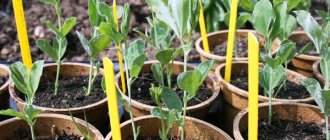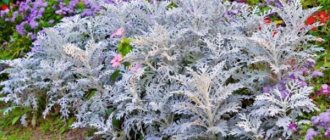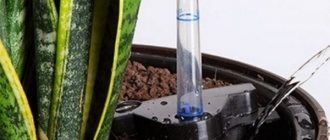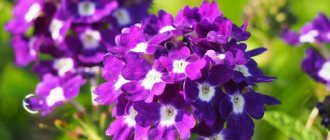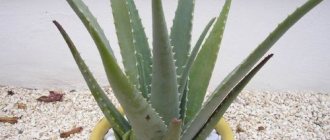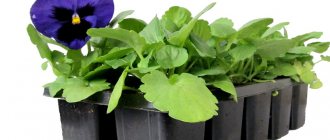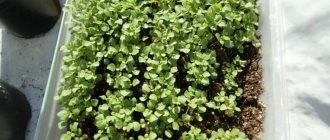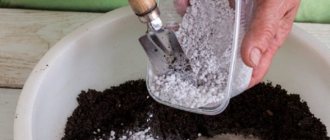The garden plant castor bean (castor bean) got its name due to the fact that its seeds are very similar to mites. In Russia, castor is also called paradise tree and Turkish hemp. Large beautiful carved castor bean leaves can decorate any part of the garden. The plant is popular among gardeners for its attractiveness and ease of care. But even when growing unpretentious crops, it is necessary to follow certain rules for planting and growing from seeds. When and how to properly plant castor beans in open ground and seedlings, you can learn how to grow a beautiful plant in the garden from our step-by-step instructions with video.
Castor bean planting dates by region and lunar calendar
First of all, we suggest that you familiarize yourself with the timing of when to plant castor seedlings in your region. And to find out the favorable days this year according to the Lunar calendar for planting castor beans for seedlings or in open ground, click on the highlighted Link.
Castor bean seeds can be sown in open ground as soon as the soil in the area warms up. In the southern regions - this is the month of April, and in central Russia, Siberia and the Urals - during May.
Since the plant grows quickly, castor bean seedlings should be planted about a month before planting in open ground. Here again you will have to navigate the weather conditions in your region, since young plants are planted in the garden at above-zero temperatures.
You will be interested to know: Feeding petunia for growth and abundant flowering: when and how to feed petunia with folk remedies and fertilizers
Approximate timing of sowing castor bean seeds for seedlings:
- In the Moscow region and other regions of the Middle Zone - from the third ten days of March to mid-April.
- In Siberia and the Urals - from mid-April to early May.
- In the Krasnodar Territory and other southern regions - during the month of March.
Recommendations for choosing a variety
Before planting castor seedlings, you need to understand which variety to use. This crop will be a wonderful addition to the landscape of the site and will give it a certain subtropical atmosphere. Here you need to start from the location, since varieties grow differently, some more, some less.
For a harmonious location on the site, you need to make the right choice.
Short:
- Zanzibar. The height reaches 2 meters, the leaves are pointed, large, purple-red in color.
- Impala. Up to 2-2.5 meters, leaves are bright, red-bronze
- Cossack girl. An interesting combination of bright green leaves on dark red stems.
- Tree of Paradise. Up to 2 meters, leaves are red-green.
- Borbonskaya. Up to 3 meters, the leaves are green in the center, the edges are deep burgundy.
Castor bean
plant Tall:
- Cambodian. 5-6 meters high, black stems, brown-red leaves.
- Gibson. Up to 4 meters, the leaves are bright red with a metallic tint.
- Northern palm. Up to 4 meters, resistant to cold, dark green leaves.
Castor bean Northern palm
There are other varieties used for industrial purposes. The shrub has valuable medicinal properties. Valuable castor oil is used in many areas.
However, you should not try to make it yourself - it is obtained using a number of chemicals that neutralize the poison of the plant in special laboratories.
You should not plant many different species, as large plantings of this crop will turn the area into thickets.
Growing castor beans from seeds
Sowing castor beans for seedlings step by step with video
Castor beans reproduce only by seeds. They do not germinate very well, so it is recommended to treat them before sowing:
- rub with sandpaper;
- soak in any of the growth stimulants, prepare a solution and use the drug according to the instructions.
Sowing castor bean seeds for seedlings step by step:
- Prepare liter containers with drainage holes and fill them halfway with soil for seedlings.
- Place two or three seeds in each container and sprinkle them with a 3-4 cm layer of soil. We sow a few seeds in case some do not hatch.
- Spray the crops with water, cover the container with cellophane and place in a warm place. Check the soil moisture every day and moisten if necessary.
After working with castor beans, be sure to wash your hands!
In about a week, the first loops of seedlings will appear, and immediately place the seedling containers in a well-lit place. If the seeds were soaked in a growth stimulant before sowing, seedlings will appear earlier.
WATCH THE VIDEO: HOW TO PROPERLY PLANT CASTORE BEANS FOR SEEDLINGS
Caring for castor seedlings
After the loops appear and the seedlings are placed on a bright windowsill, the stems will begin to appear, followed by the first leaf. Plants should be immediately removed to a loggia or other cool, bright place. The best air temperature for seedlings is about +15 degrees.
Plants are watered as needed. When the seedlings begin to grow, soil is gradually added to them.
Castor beans grow quickly, so in some cases the seedlings have to be transplanted into a larger container.
To avoid the need to replant, experienced gardeners immediately take a large transparent canister of water as a seedling container. Before sowing, a quarter of it is filled with soil. Since the container is transparent, the seedlings will have enough light. As the castor grows, you will simply need to add soil.
Description of the plant
Castor bean (Ricinus) belongs to the Euphorbiaceae family. The genus contains only one species – the common castor bean (Ricinus communis). It probably originates from Northeast Africa and the Middle East. It is believed that castor beans were originally found in Ethiopia or Eritrea, but there is no evidence.
The oldest seeds were found in Egyptian tombs dating back to 4000 BC. The plant is mentioned in the Bible (in Jonah 4:6). Papyri from 4,000 years ago contain hints about the cultivation of castor beans and the use of oil in medicine. The oil may also have been used to lubricate the stone blocks to improve their gliding when moving during the construction of the pyramids.
The plant is often mentioned in Greek, Roman and Arabic literature. The cultivation of castor beans probably spread to Persia, India and from there to China during the time of ancient Greece. In modern Europe, the plant was included in official medicine in 1788, when castor oil was approved for use by the London Pharmacopoeia.
The plant is called castor bean because the seeds resemble a bloated mite.
The species is widely distributed in tropical and subtropical regions. It is grown in many countries around the world.
Botanical description:
- Escapes – erect, woody in the lower part, branched. The shape and height of the plant depends on the climate. Under appropriate conditions, it can reach a height of 4 m. The stem is thick, with a color of green, red, dark purple (like leaves) depending on the subspecies. The stem may be hollow inside or partially filled with a pith.
- The root is strong, branched, taproot.
- Leaves – long-petiolate, located on the stem, palm-shaped, reminiscent of chestnut leaves, toothed. In our climate they can reach a diameter of 50 cm, in the tropics - 1 m.
- Flowers. The plant is monoecious, produces male and female flowers arranged in a spiral on the axis of one inflorescence. The flowers are collected in groups, the male flowers are grouped in its lower part, the female flowers are barrel-shaped, collected in the upper part of the inflorescence, with 3-5 double perianths, the pistil has a three-chambered ovary. They are mainly wind pollinated.
- Fruit. After pollination of female flowers, a spherical or oval capsule develops, covered with rather thick and long spines. Growing in clusters, the red fruits, similar to bean seeds, are one of the most poisonous parts of the plant. The fruits are three-chambered seed pods bursting at three seams. Each chamber of the box contains one seed. Seeds up to 2 cm in size, oval in shape, with a seam on the ventral side, with a hard seed coat, shiny, mosaic-colored in various colors.
This is interesting! Nectaries (honey glands that secrete nectar) are located at the nodes (the place where leaves are attached), so you can often see ants drinking nectar on castor beans. In exchange for nectar, the ants protect the plant as their fortress.
In tropical climates, it is a perennial plant - a shrub or small tree. In a Mediterranean climate, castor bean often behaves like a perennial that loses its above-ground part, only the root overwinters. In Russia, castor beans freeze in winter.
Attention! Castor bean is a highly poisonous plant, one of the most poisonous in the world. Its seeds contain a lethal dose of ricin for humans - more than 0.2 g - the amount contained in 2-3 castor bean seeds; consuming 1 seed is also dangerous for a child.
During one growing season, the plant produces shoots up to 2 m long with majestic leaves. Most varieties reach a height of 1.2-1.8 m and a width of 90 cm. Farmers call the plant an anti-mole because it effectively repels moles. Due to its considerable size, this shrub is sometimes grown in parks and gardens to hide unsightly fences or buildings.
The leaves together with the stem have great decorative value. Less decorative, but still beautiful are the spike-shaped inflorescences with extremely small green and red flowers. The seeds are the most poisonous part of the plant. Their shells are very poisonous, so it is best to remove them as soon as they ripen and begin to crack.
When and how does it bloom
The plant has rather small flowers collected in racemes. There are male and female inflorescences. The first ones have a pistil and are located at the top of the stem. The second ones have stamens, and they grow at the bottom. The fruits are hidden in the leaves and covered with thorns. The capsules are colored yellow, pink and purple, and the seeds are copper-colored with an original pattern of brown lines.
The plant is pollinated by the wind. This should be taken into account when deciding how and where to plant castor beans from seeds. Flowering begins in late July or early May and can continue until the cold weather. Blooming castor beans literally transform the area.
Decoration of the site
Planting seedlings in open ground
Seedlings are planted outside when you are completely sure that there will be no night frosts. Because the flower is afraid of cold, draft, and especially frost. Therefore, flower growers do not recommend doing this before mid-May.
The place for planting a bush needs to be well dug up, fertilized with organic matter, cleared of weeds and watered abundantly. Dig holes of such depth that the root can comfortably decompose in it.
Then fill the flower itself well with water and very carefully transfer it from the pot to the garden bed. If the pots are peat, they are placed in a dug hole.
The distance from flower to flower, in the case of group plantings, should be more than one meter.
Care after flowering
Castor beans cannot survive severe frosts, so they have to be replanted next year.
Before the onset of winter, some gardeners collect castor bean seeds for planting. This is done at the end of November. However, the seeds do not always fully ripen. It is much easier to buy them in a seed store, where they sell already selected material with good germination. Seeds collected on your own can be stored for no more than four years.
To obtain seed material, you need:
- Select the fluffiest inflorescence by removing the remaining flower stalks from the stem.
- Carefully pick and split the grown and dried fruits.
- Dry the resulting seeds for several weeks and pour them into canvas bags for storage. When winter passes, they can be grown into seedlings.
Important! The seeds are no less poisonous than the plant itself, so they must be kept away from children and animals.
